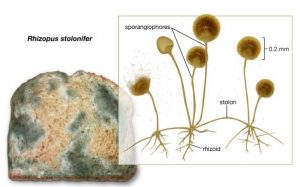Zygomycotina
Systematic position
Subkingdom: Mycota
Division: Eumycota
Sub-division: Zygomycotina
Class: Zygomycetes
- These are the second kingdom of fungi known as the conjugated fungi.
- They majorly include the bread mold, Rhizopus Stolonifer.
- Approximately 1060 species are known.
General Characteristics
- These are true fungi
- They have a well developed and haploid filamentous thallus
- This consist of branched mycelium and coenocytic multinucleate hyphae due to the absence of septum.
- The septum is not present in early stage but formed during the reproductive stage
- A few mycelia produce rhizoids.
- The cell wall is made up of chitin and chitosan
- The mode of nutrition may involve parasitic or saprophytic associations
- Also, there are certain destructive plant pathogens causing disease.
- The zygospore formation is the characteristic feature in this fungus that contains sporopollenin which is present in the outer wall of spores.
- This protects them from desiccation and other unusual conditions
- They are mostly terrestrial in habitat, living in soil or on decaying plant or animal material.
- They show sexual and asexual reproduction
Hyphae
There are 3 types of hyphae present in this fungi-
- Stolon- This grow horizontally
- Rhizoids- These are root-like structures present in tufts. They help in attaching mycelium to the substratum.
- Sporangiospores- These are present on the specialized hyphae. These are majorly erect, Arial and unbranched hyphae which also grow as tufts. These are reproductive in nature as they bear sporangium.

Habitats
- They are found mostly in terrestrial habitat ie on soil or decaying plants and animals or may be aquatic
- They may be parasites on arthropods, plants or fungal hosts
- They may also have symbiotic associations
Classifications
Zygomycotina is subdivided into 2 classes
- Zygomycetes
- Trichomycetes
Reproduction
They show sexual and asexual reproduction
Asexual Reproduction
They majorly reproduce by asexual reproduction.
- Sporangiospores- They reproduce by sporangiospores when they have all the required nutrients available ie. they search for favourable conditions. They produce by forming a sac-like structure called sporangium around the sporangiophore. They are then passed by the wind current as the rupture takes place and the sporangiospores are placed into other suitable growing conditions.
Sexual Reproduction
Sexual reproduction occurs in adverse conditions.
- Gametangial Copulation- The two opposite mating strains fuse their hypha to form diploid zygosporangia. A thick wall is formed between the two hyphae and there are zygospores inside it. Thatswhy it is known as conjugated fungi. Also, the meiosis takes place once they got proper nutrition and development conditions.
Lifecycle
It occurs in three phages
- Haploid Phase (n)
- Diploid Phase (2n)
- Dikaryotic Phase (n+n)

- Plasmogamy- The protoplasm of two mycelia fuses together without the fusion of nuclei, forming two haploid nuclei in the same cell.
- Karyogamy- It occurs when two opposite strains of fungi fuse together to form one diploid nucleus. Later they undergo meiosis and form zoosporangia. It is the final step and form sporangiospores when conditions are favourable.

Economic Importance
- These are opportunistic human pathogen that rarely causes human disease.
- They are saprophytic in nature that depends on dead and decaying plants and animals, dung which ultimately helps in the carbon cycle.
More Topics To Read
